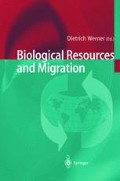Abstract
Rhizobia are soil bacteria that form nitrogen-fixing nodules on leguminous plants. Three possible ways have been estimated for the long-distance transport of these bacteria: by introduction of legume seeds or plants that are accompanied naturally by rhizobia, by application of rhizobial inoculants, and by rivers that carry rhizobia downstream. In all these three forms, or any other possible way, rhizobia are moved passively and they have to face biotic and abiotic factors in a new environment. So, a successful migration of rhizobia mainly depends on whether they can colonize in the new environment after transportation. Since rhizobia are symbiotic bacteria associated with legumes, their colonization in new environments depends on both their host plants and environmental factors. The colonization of rhizobia is easier when the new environment is similar to the old and the host plants have restricted nodulation ability, as with the introduction of Amorpha fruticosa from USA to China. In contrast, the introduced rhizobia may be eliminated if the new environment is quite different and the hosts can nodulate with a wide range of rhizobia, as in the case of soybean. In any event, a successful migration of rhizobia can affect the local microbial community by the establishment of a new bacterial population and by the lateral gene transfer of symbiotic genes or other genetic elements. Here, some investigations relative to rhizobial migration will be reviewed.
Access this chapter
Tax calculation will be finalised at checkout
Purchases are for personal use only
Preview
Unable to display preview. Download preview PDF.
References
Andrade DS, Murphy PJ, Giller KE (2002) The diversity of Phaseolus-nodulating rhizobial populations is altered by liming of acid soils planted with Phaseolus vulgaris L. in Brazil. Appl Environ Microbiol 68: 4025–4034
Laguerre G, Louvrier P, Allard MR, Amarger N (2003) Compatibility of rhizobial geotypes within natural populations of Rhizobium leguminosarum biovar viciae for nodulation of host legumes. Appl Environ Microbiol 69: 2278–2283
Pérez-Ramirez NO, Rogel-Hernandez MA, Wang ET, Martinez-Romero E (1998) Seeds of Phaseolus vulgaris bean carry Rhizobium etli. FEMS Microbiol Ecol 26: 289–296
Rivas R, Willems A, Suba-Rao NS, Mateos PF, Dazzo FB, Kroppenste RM, Martinez-Molina E, Gillis M, Velazquez E (2003) Description of Devosia neptuniea sp. nov. that nodulates and fixes nitrogen in symbiosis with Neptunia natans, an aquatic legume from India. Syst Appl Microb 26: 47–53
Schwieger F, Tebbe CC (2000) Effect of field inoculation with Sinorhizobium meliloti L33 on the composition of bacterial communities in rhizospheres of a target plant (Medicago sativa) and a non-target plant (Chenopodium album) - linking of 16S rRNA gene-based single-strand conformation polymorphism community profiles to the diversity of cultivated bacteria. Appl Environ Microbiol 66: 3556–3565
Sullivan JT, Patrick HN, Lowther WL, Scott DB, Roson CW (1995) Nodulating strains of Rhizobium loti arise through chromosomal symbiotic gene transfer in the environment. Proc Natl Acad Sci USA 92: 8985–8989
Van Berkum P, Eardly BD (2002) The aquatic budding bacterium Blastobacter denitrificans is a nitrogen-fixing symbiont of Aeschynomene indica. Appl Environ Microbiol 68: 1132–1136
Wang ET, Martinez-Romero E (2000) Sesbania herbacea-Rhizobium huautlense nodulation in flooded soils and comparative characterization of S. herbacea-nodulating rhizobia in different environments. Microbiol Ecol 40: 25–32
Wang ET, van Berkum P, Beyene D, Sui XH, Chen WX, Martinez-Romero E (1999) Diversity of rhizobia associated with Amorpha fruticosa isolated from Chinese soils and description of Mesorhizobium amorphae sp. nov. Int J Syst Bacteriol 49: 51–65
Wang ET, Rogel MA, C XH, Chen WX, Martiez-Romero E, van Berkum P (2002) Mesorhizobium amorphae, a rhizobial species that nodulates Amorphae fruticosa, is native to American soils. Arch Microbiol 178: 301–305
Author information
Authors and Affiliations
Editor information
Editors and Affiliations
Rights and permissions
Copyright information
© 2004 Springer-Verlag Berlin Heidelberg
About this paper
Cite this paper
Wang, E.T., Chen, W.X. (2004). Estimation of Biotic and Abiotic Factors That Affect Migration of Rhizobia. In: Werner, D. (eds) Biological Resources and Migration. Springer, Berlin, Heidelberg. https://doi.org/10.1007/978-3-662-06083-4_16
Download citation
DOI: https://doi.org/10.1007/978-3-662-06083-4_16
Publisher Name: Springer, Berlin, Heidelberg
Print ISBN: 978-3-642-05989-6
Online ISBN: 978-3-662-06083-4
eBook Packages: Springer Book Archive

